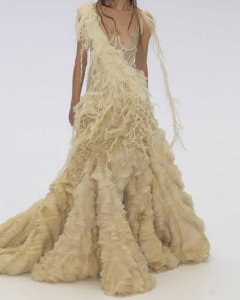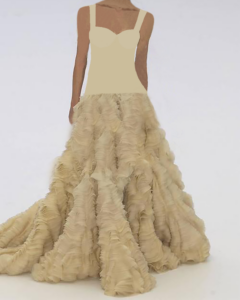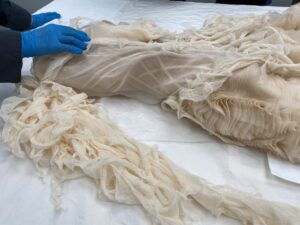“A strange tissue of space and time”: in search of aura’s logic
“What then is the aura? A strange tissue of space and time: the unique apparition of a distance, however near it may be.”
By Lily Turri
Atop the dresser in my sister’s bedroom, are two stacks of plastic containers filled with objects from my childhood. Some highlights from the collection include, Cinderella and Prince Charming dolls that (as far as I know) I never played with, mounds of floral-printed purses, and a pair of sunglasses that made me feel incredibly glamorous at about age ten. Near the top of this container mountain lies, what is to me, the most captivating object of the bunch–a princess slipper I wore at age four while hiking in the New Mexico desert. There’s only one (though my mother tells me the other one must be “somewhere in this house”) which undoubtedly adds to its allure. Its lace is scuffed, its blue satin bow roughed up and folded over, and fifteen-year-old dirt is embedded in its sole. I love this old dirty shoe.
What is the allure of such an object? According to Walter Benjamin, what this shoe has is aura. In his essay, “The Work of Art in the Age of Mechanical Reproduction,” he writes, “What then is the aura? A strange tissue of space and time: the unique apparition of a distance, however near it may be.” Though I think he captures something of the intangible essence of objects in this description, I am curious if we can do better.
Fast forward to our visit to the Met Costume Institute, a day I looked forward to for weeks. Looking through the objects on the bus ride there, I had a gut feeling that I was going to select Alexander McQueen’s “Oyster Dress” for my final project. I knew this before I had any idea of what I was going to write about. And that was because, from the photographs alone, I was struck by its aura. I, however, was a bit concerned, because my thoughts at this point mainly consisted of “Wow this dress is so cool; I want to wear it!” I could not write a paper based on adoration alone.
Or maybe, in a way, I could. Studying the dress in person, I was able to begin thinking through what attributes made this dress so fascinating to me. With time, I realized that Benjamin’s concept of aura manifests itself quite vividly in the “Oyster Dress.” Hence, in my modified version of the dress (which I have deemed “Oyster Prom Dress”), I have sought to strip the gown of its aura. Through an examination of Oyster Dress(es), I hope to elucidate a more concrete understanding of the attributes of auratic objects than Benjamin’s description affords us. Particularly, I would like to suggest that this “apparition of a distance” can manifest itself as a series of ambiguities—of past, of use, of the separation of exterior from interior—expressed visually on an artifact’s surface.


I would like to begin by describing the Oyster Dress’s parts, including those elements which are not as visibly apparent from a distance. The Oyster Dress is a floor-length gown in a color that could be described as shell or bone. In it, a semi-sheer corseted bodice sits atop a voluminous ruffled silk skirt, the meeting point of which is obscured by a cascade of fabric strips made from a delicate gauze. This fabric waterfall passes over the midriff and the left side of the chest, arriving at a graceful conclusion on the left shoulder. The right side of the bodice is left unlined, exposing the bare chest underneath; the material of the bodice extends to a thin tapered strap on the right shoulder. Gauze strips are tied to this strap, creating a kind of sash, hanging freely to move with the body. The full effect is elegant but untamed, disheveled though stately.
Stripping the Oyster Dress of its aura requires us to both strip down a layer and insert a new one. To create Oyster Prom Dress, I “cut” away its many layers of cascading gauze, revealing the junctures of bodice to skirt and dress to body. I covered the see-through corset bodice with an opaque fabric and added sizable straps of the same material, removing the connotations of lingerie from the dress.
When present, the gauzy fabric strips create an illusion of pastness. We are not pointed towards one singular past. Rather, we are provided with indications of the existence of some past. The gauze appears as fragments, torn or unraveled. It is unknown whether the garment is tattered or decayed. We cannot determine if the “destruction” of the gown was at the hands of the wearer, or inflicted upon her. It feels equally feasible that the gown is not a gown at all but an extension of her body. Is she a mermaid, a victim, a goddess? All of the above? None of these interpretations are wholeheartedly supported, nor thoroughly discounted. The Oyster Dress wears its “past,” but we cannot uncover it. It is the incompleteness of its pastness that is precisely what gives the dress aura. In this way, the Oyster Dress reveals that the “apparition of a distance” Benjamin describes can take shape as an ambiguous past, one that is hinted at visually but cannot be placed.
To underscore the auratic nature of ambiguous pastness, I have attempted to remove all traces of a past from the Oyster Prom Dress. Not a singular gauze strip has eluded me in my quest for aura removal. Without its trusty amorphous gauze, the dress that eluded answer cannot do so so easily.
In Oyster Dress, the bodice’s semi-nudity enables aura to also manifest itself as an ambiguity of interior/exterior relation. In the garment, a membrane-like fabric allows our gaze to permeate the bodice. However, this visual permeation is incomplete, as most of the bodice is obscured by gauziness. The effect is likened to clouded glass in front of a bather; our voyeurism can only go so far. In Oyster Prom Dress, transparency is removed, causing the dress to lose this flirtation with the nude. Here, “the stripping of the veil from the object, the destruction of the aura” requires a literal destruction of the veil. In this case, to destroy the veil isn’t to create full nudity of the bodice, but to reinstate gown as gown, rather than gown/undergarment. Filling in the bodice both asserts gown-ness and removes the palpability of the body, closing the “apparition of a distance” that the semi-nude enables.
This assertion of the gown typology in Oyster Prom Dress also works to curb ambiguities of where the garment positions itself in the process of dressing and thus the occasion of its usage. Key elements of the dress—bodice, gauze assemblages, skirt—suggest different points in the duration of wear. The bodice contains boning akin to corsetry. Corsets typically act as a scaffolding on which dresses are placed, not an end in and of themselves, implying that dressing is in progress. This contrasts with the skirt which reads evening gown, indicating a completion of the dressing process. The gauze strips, on the other hand, are markers of a journey, either accumulated or torn apart along the way to getting here. In this way, they disrupt both the possibilities of mid-dressing and post-dressing. Together, these elements further impair our reading of the Oyster Dress as simply an evening gown. This vagueness of where we stand in the duration of the wearing experience and by extension, of the intended use of this garment, generates aura. By eliminating the corset and gauze, Oyster Prom Dress becomes undoubtedly an evening gown.

What the Oyster Dress does so well is tease us with abundant questions, and thus abundant possibilities, of its past. Seeing it up close, I learned that this goes so far as the obscuring of its construction. In the image above, you can see how the meeting point of the bodice and skirt has gauze ringlets tacked to it, allowing for a merging of the elements that feels natural when worn. The final quality I wanted to eliminate from the Oyster Dress through modification was this erasure of constructing, of making. In Oyster Prom Dress, our musings about the garment’s past become jolted away from the realm of fantasy and into the world of reality. We may wonder about the number of hours it took to make the dress and the painstakingness of this labor. Aura lets us evade such realities at least temporarily.
Before attempting to erase the Oyster Dress of its aura, I felt fairly certain that aura was an indescribable quality, something that (joyfully) escapes the grasp of logical explanations. What I have learned, however, is that eluding neatly packaged explanations, and thus subverting expectations we are conditioned to have, is exactly the logic that aura follows. Thinking back to my well-loved, well-worn princess shoe, I can see now that it has a past I can only partially conjure. This is a past that is likely remembered only as it was relayed to me, though it visibly bears its existence on my shoe. Daintiness and ruggedness coexist here, an “impossibility” we see in the Oyster Dress as well. I am curious now if there is an artifact from your own life that exhibits similar evasions of prescribed explanations, a supposed contradiction of your own. I now see the potential of aura to not only subvert such prescribed explanations but to, someday, upend them.
Works Cited:
Benjamin, Walter “The Work of Art in the Age of Mechanical Reproduction”
Image of dress detail by author
This paper represents my own work in accordance with University regulations.
Lily Turri

